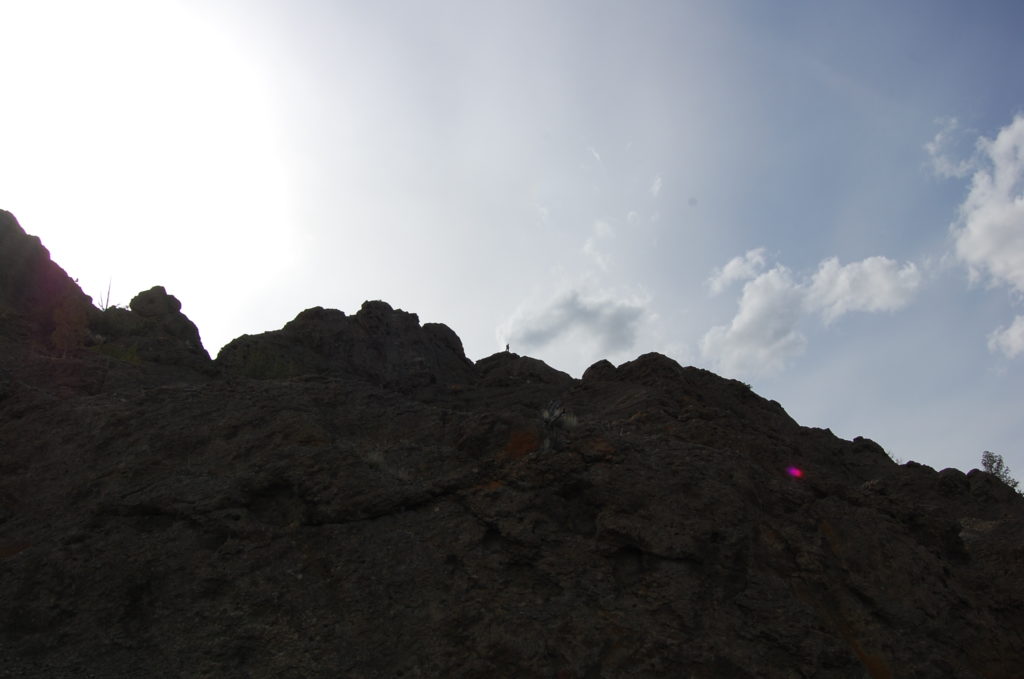Matthew Nikitczuk is a graduate student at Brock University exploring subsurface microbial activity in hydrovolcanic rocks. You can read more about Matthew’s research here.
I find that one of the most interesting applications of geology is in that of planetary science. Of course, the focus of geology itself is to study the planet which we inhabit (Earth), but where things really become interesting is when we attempt to consider how these studies of our own amazing planet can be useful for understanding the intricate histories of extraterrestrial bodies such as moons or other planets within our solar system and beyond. Here, I am referring to planetary analog studies. In such cases, we can take information that has been gathered on extraterrestrial bodies by remote sensing instruments such as imaging satellites, landers or rovers, and look in detail at specific places on Earth which appear to share similar characteristics such as rock type, chemical composition, geomorphology, or any other identifiable factors. In doing so, one can begin to infer past or present environmental conditions and make predictions about what other features and processes may be present/occurring yet unidentified in these extraterrestrial environments. Over the last nearly four years, under the supervision of Dr. Mariek Schmidt, Associate Professor at Brock University, I’ve been fortunate to have had the opportunity to be involved in such research. What originally began as an undergraduate thesis project in 2012 metamorphosed into a Master’s thesis and a total of approximately 3.66 years of research involving travel to the Oregonian desert during two field seasons and copious and various laboratory analyses. The focus of this research has been on a location in central Oregon, U.S.A., known as the Fort Rock-Christmas Valley basin or Fort Rock volcanic field, as a Martian analog.

One of the largest hydrovolcanic features in the Fort Rock-Christmas Valley basin, the Fort Rock monument (tuff ring). Photo by Matthew Nikitczuk.
So what is it about the Fort Rock basin that makes it a suitable candidate for a Mars analog study? To answer this, let’s consider the geology of the area and some results of the study. During the Pliocene-Pleistocene (<2.59 Ma to 12 ka), the basin, which is approximately ~2400 km 2, was the site of an ancient pluvial lake. Evidence such as extensive diatomite beds, wave-cut terraces, and aquatic bird and fish fossils support the lake’s existence. Throughout the period during which the Fort Rock lake existed, many volcanic eruptions occurred both within and around the basin, mainly controlled by a series of NW-trending faults throughout the area. Those eruptions that occurred either very near or within the lake resulted in hydrovolcanic eruptions whereby the interaction of magma with external ground or lake water caused multiple explosive pulses essentially driven by the instantaneous production and expansion of steam/water vapour. Although there is bimodal volcanism in the area, the majority of rocks are basaltic in composition. The result of those hydrovolcanic eruptions is the production of circular structures known as tuff rings, tuff cones, or maars, depending on the depth at which magma interacted with water and/or the depth of the surface water. These structures are composed of layered pyroclastic material that dip in a radial fashion away from and toward the vent (quaquaversal). Since the magma interacted with external water and cooled very rapidly, the main pyroclastic component is vesiculated basaltic volcanic glass or sideromelane.

Dr. Mariek Schmidt being interviewed by the Discovery Channel in front of the Fort Rock tuff ring. Photo by Matthew Nikitczuk.
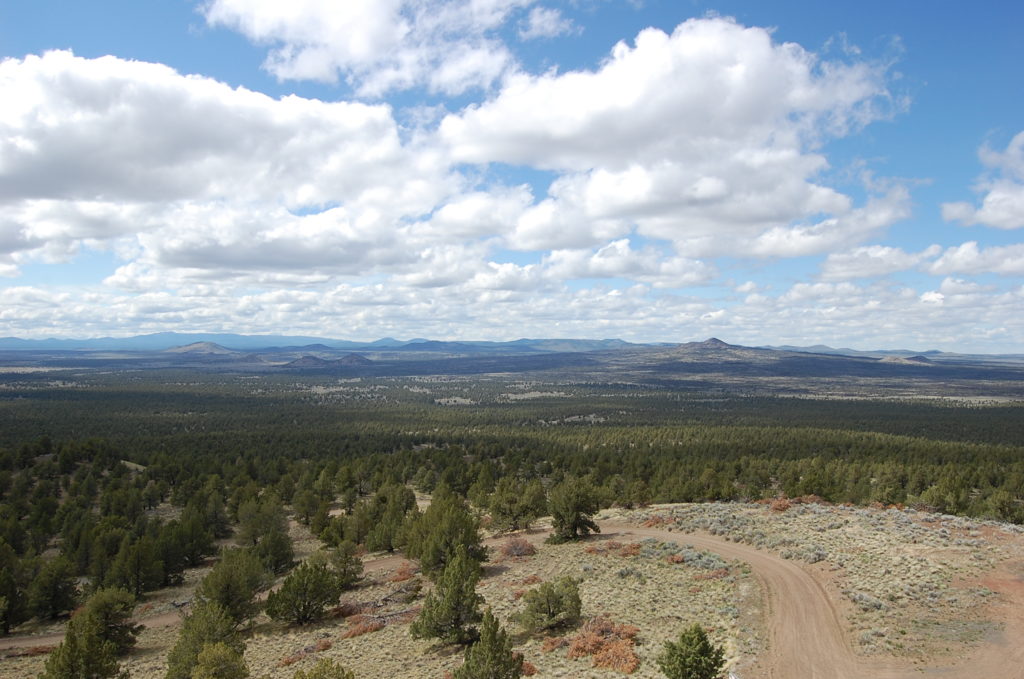
A view of the Fort Rock basin from atop Green Mountain. Multiple volcanic peaks can be seen in the distance across the landscape. Photo by Matthew Nikitczuk.
After traveling more than 3000 km across North America, we found ourselves camping atop a hundred thousand year old scoria cone (Green Mountain) in the middle of the Oregonian desert. One standing atop Green Mountain can look about and see volcanic peaks piercing the horizon in every direction. Each day we set out traversing back and forth across this ancient lake basin, from scoria cone, to lava flow, to tuff cone, to maar in search of both pristine unaltered lavas, and fresh to highly altered tuffs. Criss-crossing the basin are dirt roads, 4 wheel drive trails and cow fences. We were able to drive the larger distances between sites, but the roads only go so far. Plenty of hiking. It was a good thing we got the full insurance coverage for the rental 4×4 vehicles, because we did have to drive over some lava flows, and along trails with thick, dry bushes that scratched the hell of the sides. The area is also a mix of public and private lands so unfortunately there were some areas we would have liked to sample but could not get access to. Lots of local gun owners in the area. It wasn’t uncommon to find bullet holes in signs and shell casing at the bases of tuff outcrops.

A view from inside the Reed Rock tuff ring. The outer tuff layers are visibly dipping to the left, away from the vent. Photo by Matthew Nikitczuk.
We also ventured into a lava tube (Derrick Caves), overgrown spatter cone (The Blowouts), and large fractures within thick lava flows (Crack-in-the-Ground) all of which are humbling, mesmerizingly beautiful and geologically spectacular. Anyways, out in the middle of the desert, the ever increasing temperatures and lack of shade are unrelenting. It is nonetheless very peaceful. So, we unstintingly looked for representative rocks with a range of varying characteristics that include differences in grain size, layer thickness, secondary precipitate content (vugs, amygdules) and colour. What was initially of main interest to us, was how these rocks or the glass contained within the rocks, altered in the presence of hydrothermal/low temperature fluids. By examining the assemblage of secondary minerals that form as a result aqueous alteration, it is possible to determine roughly what the paleo-environmental conditions, such as temperature or fluid pH, were during the time of their formation. The shards of volcanic glass readily alter in the presence of water resulting in distinct colourations. So in the field, colours in tuffs, especially those that appear a bright orange to yellow, are a good indication that the rocks experienced substantial aqueous alteration. The colour of which is attributed to a material known as palagonite that forms when volcanic glass is altered from an amorphous gel to increasingly more crystalline secondary phases that may include smectite clays, zeolites, and Fe-oxyhydroxides.

A hydrovolcanic feature in the Reed Rock deposits known as a ‘bomb sag’. The lava bomb in the upper portion of the photo was deposited into the lower layers when they were saturated with water. The layers were thus plastically deformed. Photo by Matthew Nikitczuk.

A view from inside the Black Hills study site. Several peaks that are portions of intermingled tuff rings are visible. The largest one on the right actually has an intrusive dike. Dr. Mariek Schmidt at left, searching for samples. Photo by Matthew Nikitczuk.

Frank Popoli, another Master’s student of Dr. Schmidt’s, examines an exposure or curved layers of tuff at the top of a tuff ring in the Black Hills. Photo by Matthew Nikitczuk.
During two trips to the Oregonian desert in the summers of 2012 and 2013, and with the help of Nevena Novakovic (fellow undergraduate at the time), Frank Popoli (another Master’s student of Mariek’s), Jeff Berger (PhD student under Mariek), and Rebekka Lee (undergraduate), we collected over 130 samples as part of a regional study, totalling over 100 kg. I personally went through 4 sledge hammers (Nameless, Slugger, Papa Sledge, and Nameless.2) during field work, breaking hammer handles on extremely hard basaltic lava flows, dikes, or agglutinates. Those which were the focus of my undergraduate and master’s research were from two specific sites that contained several tuff rings. The first study site, known as Reed Rocks, contained two tuff rings (Reed Rock and South Reed Rock), whereas the second study site, the Black Hills, appeared to be a cluster of ~six tuff rings mashed together. The distinct dipping layers, representing individual explosive pulses, are especially prominent at the Reed Rocks site, and are intermittently obvious throughout the Black Hills.

Matthew Nikitczuk sits inside a windblown cavity on the face of a tuff outcrop in the Black Hills. Photo by Nevena Novakovic.
On an interesting note, during our first stint of field work in summer 2012, we spent one entire day being filmed by the Discovery Channel’s Daily Planet. My supervisor Mariek is one of the participating scientists on the Mars Science Laboratory (MSL) mission, and so I was fortunate enough to have been an MSL student collaborator over the last few years. We were being filmed for the special daily planet episode about MSL called Mars Landing 2012: The New Search for Life.

Matthew Nikitczuk pondering Oregonian geology from within the Black Hills. A volcano with a flat lava cap top is visible in the distance. Photo by Nevena Novakovic.
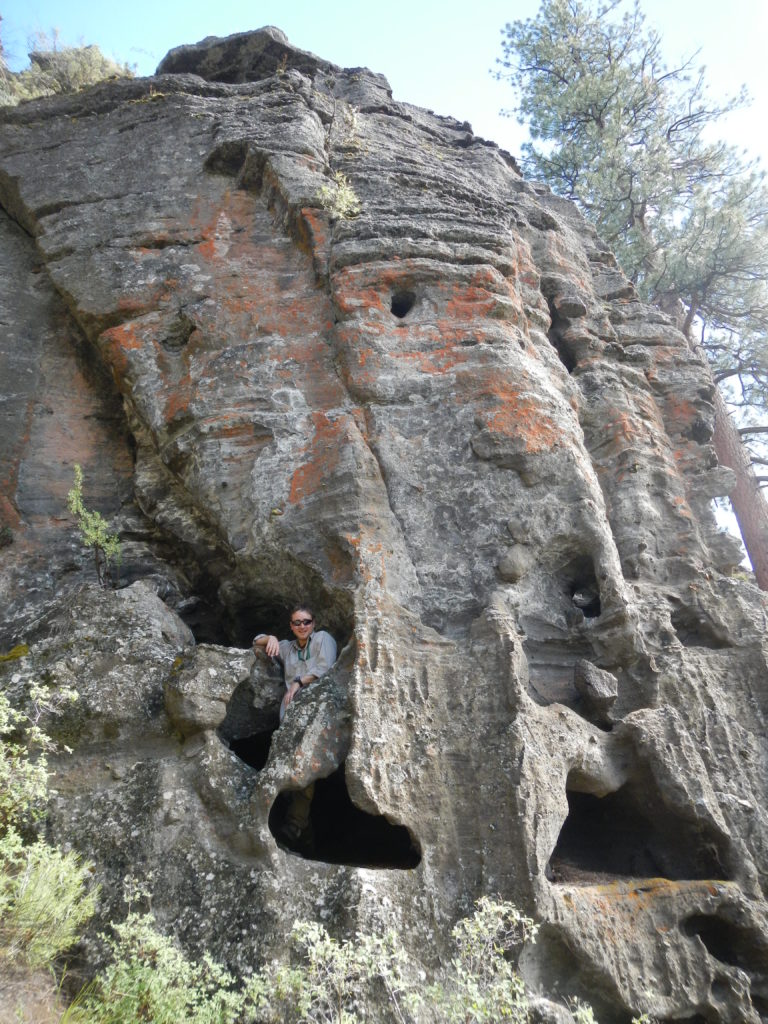
Matthew Nikitczuk standing inside a cavity within a layered tuff deposit of Hole-in-the-Ground maar. Photo by Frank Popoli.
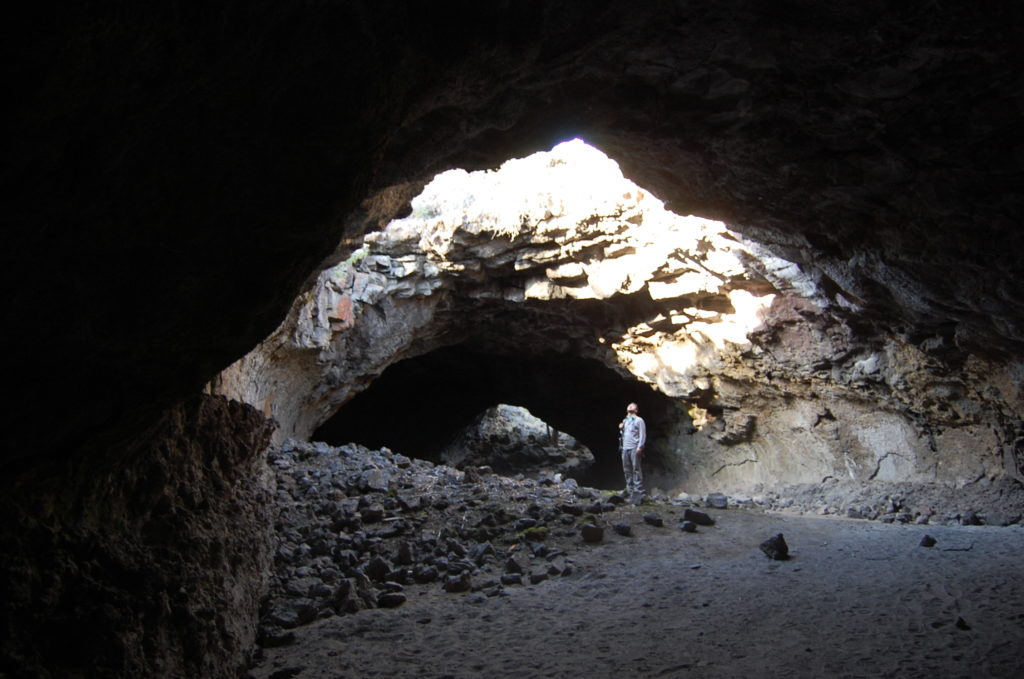
Matthew Nikitczuk standing inside the Derrick Caves lava tube. A large sky light can be seen in the roof of the lava tube letting the sunlight in. Photo by Nevena Novakovic.
The majority of lab analysis entailed detailed petrographic examination, but in addition, scanning electron microscopy, energy dispersive spectroscopy, micro and powder X-ray diffraction, oxygen isotopes, and X-ray fluorescence were also part of it. Much of these analyses were completed at the University of Western Ontario. After quite some time staring at a series of thin sections through the microscope, I noticed something peculiar in one sample that I collected from Reed Rock (sample FR-12-97E). Surrounding a vesicle within a glassy pyroclast, there were what appeared to be various microscopic tunnels radiating from the vesicle and propagating into the glass (when the lava was cooling, degassing caused the formation of bubbles which solidify as round pockets in the glass, forming vesicles). I was not quite sure what I was seeing, but I knew I had seen something similar before in some journal article I had previously read. After showing my supervisor Mariek, and a couple other professors around the Earth Sciences Department at Brock, I was convinced that these features were in fact produced my some sort of microbe ‘eating’ their way through the glass. I believed that these features were in fact microbial trace fossils. Once I saw them in one sample, I began to see them in many other samples.

Matthew Nikitczuk standing atop an overgrown spatter cone known as The Blowouts. Photo by Nevena Novakovic.
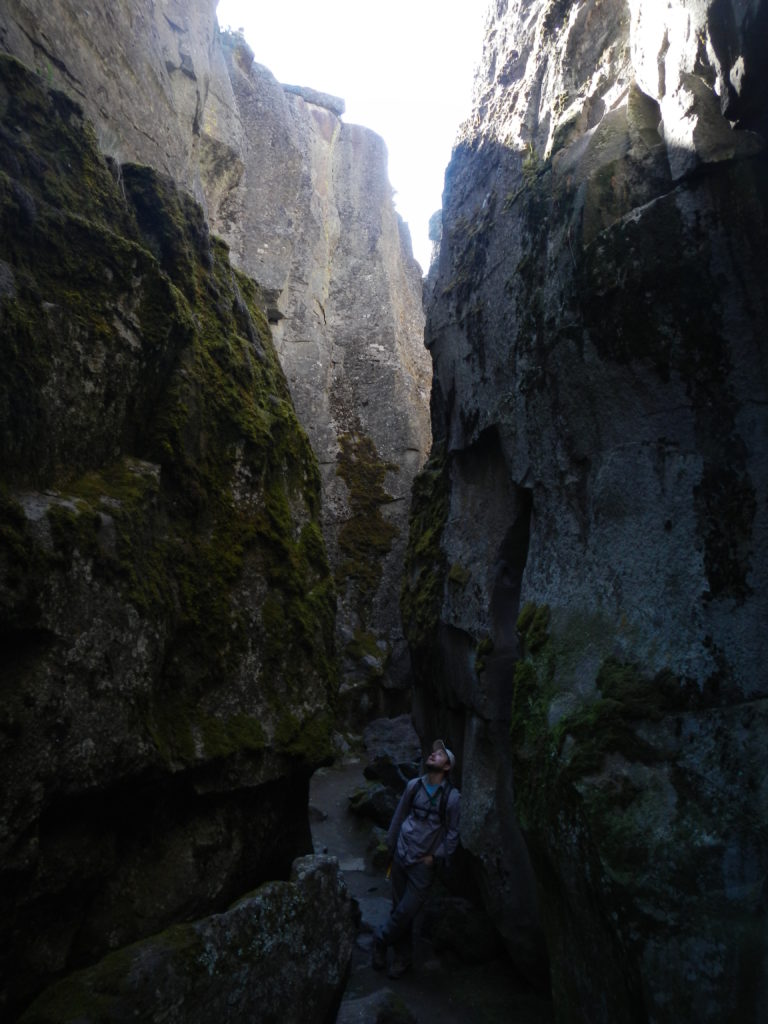
Matthew Nikitczuk standing inside a large open fracture (Crack-in-the-Ground) within a lava flow. Photo by Nevena Novakovic.

Matthew Nikitczuk standing in the middle of a lava field during a trek to collect samples from a cinder cone at its center. Photo by Frank Popoli.
Upon further research into the matter, I found that tubular features like these have been documented extensively in basalts from oceanic crust, as well as some other sub-glacially erupted basalts. They are known as endolithic microborings. But to my delight, I discovered that microborings, or at least micro-tubular features resembling anything documented beneath the oceans or glaciers, had not been described in basalts that erupted in a continental lake environment. It seems that this was the first account of tubular microtunnels believed to endolithic microborings in basalts erupted in a non-marine, non-subglacial environment. So, like many great discoveries in science, I found something that we were not looking for, did not expect to find, yet completely enhanced the project. Now, not only was the project about determining paleo-environmental characteristics based on mineral assemblages and even more compelling as a Mars analog study, but it had another more directly astrobiological aspect. One of the purposes of constructing paleo-environments is to determine the conditions of biological habitability, and it now seemed that there was some direct evidence suggesting that these basaltic tuffs are habitable to microbes.
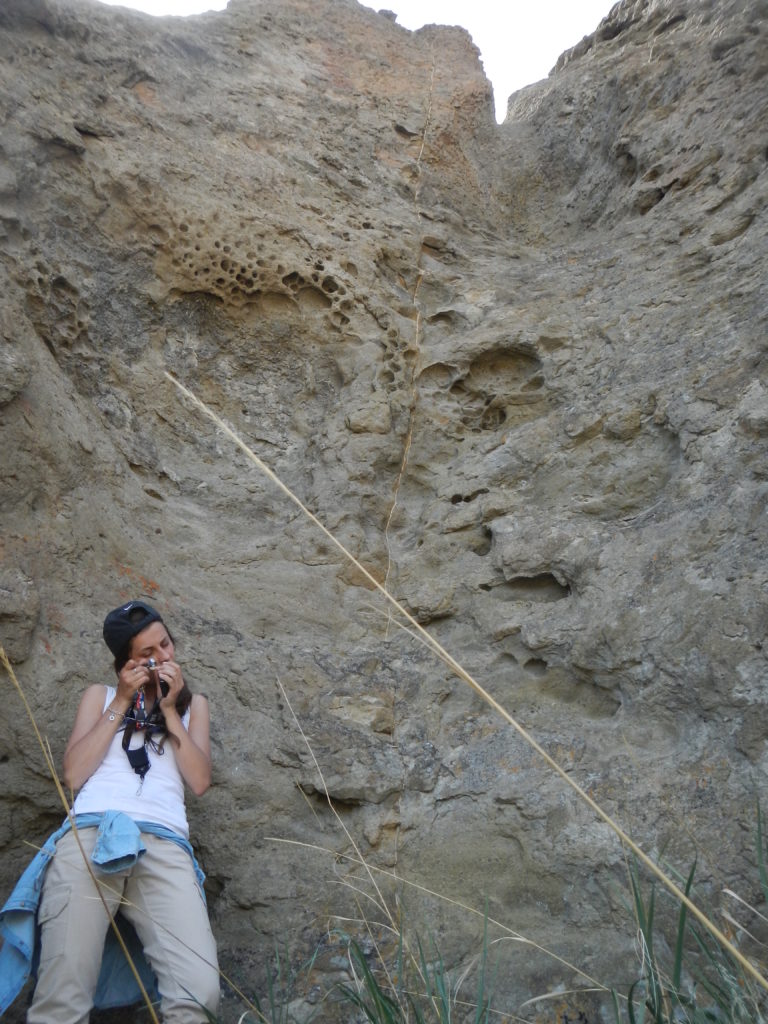
Nevena Novakovic examining a portion of tuff in the Black Hills up close with her hand lens. Photo by Matthew Nikitczuk.

Two weeks-worth of tuff and lava sample from throughout the Fort Rock basin. Photo by Matthew Nikitczuk.
Across Mars, not only are there lots of basaltic volcanic rocks, but there is also evidence of hydrovolcanism, pyroclastic deposits, amorphous materials that may consist of glass, ancient lake environments, hydrothermally altered rocks, secondary minerals such as phyllosilicates (smectites) and zeolites, and subsurface liquid water. In addition to these characteristics that are shared with our study site, there appear to be these tubular microtunnels within the Fort Rock deposits. Since such features have only been found in deep ocean rocks and subglacial rocks, their presence in the Fort Rock tuffs show that they can be produced in surficial hydrovolcanic pyroclastic deposits. Who knows, it may be possible that similar features, if present on Mars, could be the type of bio-signature we’ve been searching for and may be found nearer to the surface that previously thought. The hope with this study and future studies is that new information will help us to not only understand the conditions and mechanisms of tubular microtunnel production but will also be taken into account in the search for biosignatures and the choosing of suitable rocks for remote rover analysis and sample return missions. There is plenty more work to be done.

Enhanced depth of focus photomicrograph of tubular microtunnels in basaltic glass radiating from a vesicle. Each tunnel is ~1 µm in diameter. Sample is from Reed Rock tuff ring. Photo by Matthew Nikitczuk.

Enhanced depth of focus photomicrograph of tubular microtunnels in basaltic glass rooted on a fracture. Each tunnel is ~1 µm in diameter. Sample is from Black Hills study site. Photo by Matthew Nikitczuk.
For more about this research you can find our recently published article in the Geological Society of America Bulletin entitled, “Candidate Microbial Ichnofossils in Continental Basaltic Tuffs of Central Oregon, USA: Expanding the Record of Endolithic Microborings”.
![]() This work is licensed under a Creative Commons Attribution-NonCommercial-ShareAlike 4.0 International License.
This work is licensed under a Creative Commons Attribution-NonCommercial-ShareAlike 4.0 International License.


